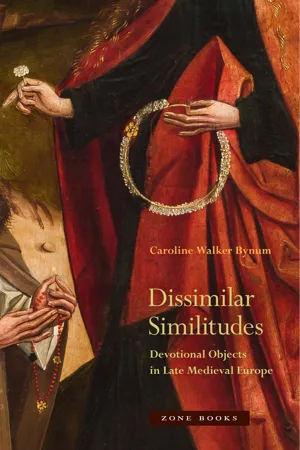
Dissimilar Similitudes
Devotional Objects in Late Medieval Europe
Caroline Walker Bynum
- English
- ePUB (mobile friendly)
- Available on iOS & Android
Dissimilar Similitudes
Devotional Objects in Late Medieval Europe
Caroline Walker Bynum
About This Book
From an acclaimed historian, a mesmerizing account of how medieval European Christians envisioned the paradoxical nature of holy objects Between the twelfth and the sixteenth centuries, European Christians used a plethora of objects in worship, not only prayer books, statues, and paintings but also pieces of natural materials, such as stones and earth, considered to carry holiness, dolls representing Jesus and Mary, and even bits of consecrated bread and wine thought to be miraculously preserved flesh and blood. Theologians and ordinary worshippers alike explained, utilized, justified, and warned against some of these objects, which could carry with them both anti-Semitic charges and the glorious promise of heaven. Their proliferation and the reaction against them form a crucial background to the European-wide movements we know today as "reformations" (both Protestant and Catholic).In a set of independent but interrelated essays, Caroline Bynum considers some examples of such holy things, among them beds for the baby Jesus, the headdresses of medieval nuns, and the footprints of Christ carried home from the Holy Land by pilgrims in patterns cut to their shape or their measurement in lengths of string. Building on and going beyond her well-received work on the history of materiality, Bynum makes two arguments, one substantive, the other methodological. First, she demonstrates that the objects themselves communicate a paradox of dissimilar similitude—that is, that in their very details they both image the glory of heaven and make clear that that heaven is beyond any representation in earthly things. Second, she uses the theme of likeness and unlikeness to interrogate current practices of comparative history. Suggesting that contemporary students of religion, art, and culture should avoid comparing things that merely "look alike, " she proposes that humanists turn instead to comparing across cultures the disparate and perhaps visually dissimilar objects in which worshippers as well as theorists locate the "other" that gives religion enduring power.
Frequently asked questions
Information
Index
- ABELARD, PETER, 112, 288 n. 45.
- Absence, as one pole of paradox, 52, 89, 230, 251, 258, 280 n. 60, 327 n. 62; as containing presence, 55, 179, 227, 245, 258; as pointing beyond itself, 222, 258; see also Presence; Trace.
- Adamnam of Iona, 230, 322 n. 30.
- Adam’s Peak, Sri Lanka, 223.
- Adiaphora (objects of indifference), 98, 262 n. 15, 269 n. 57, 282 n. 75, 284 n. 5, 303 n. 32, 308 n. 2.
- Advent, 65, 75.
- Agency, see Objects, agency of.
- Akeldama (The Potter’s Field), 242, 243, 326 n. 54.
- Alchemy, 39, 146.
- Aller, river, 109.
- Altcelle, 97.
- Altdorfer, Albrecht, 247, 248 fig. 6.11, 258, 277 n. 16.
- Altenberg Altar, 121, 126–27 figs. 2.12a–b.
- Altötting, Virgin of, 177.
- Amarnath cave, 207 fig. 5.11.
- Amico, Bernardino, 323 n. 35.
- Amulet, 17, 21, 25 fig. 1.8, 38, 162, 171, 173, 187, 199, 241 fig. 6.9.
- Andechs, miraculous hosts at, 172, 304 n. 45.
- Andrew, saint, 22 fig. I.5.
- Aniconic, see Objects, aniconic.
- Anna-Selbdritt, 78, 80, 82 fig. 1.11, 279 n. 49; see also Anne, saint.
- Anna-Selbviert, 80, 83 fig. 1.12; see also Anne, saint; Emerentia, great grandmother of Jesus.
- Anne, saint, mother of Mary the Virgin, 80, 83 fig. 1.2, 279 nn. 49–50, nn. 52–54, 286 n. 23.
- Annunciation, 21, 23 fig. I.6, 42, 50.
- Anthropomorphism, 139–42, 148, 215, 295 nn. 32–34, 316 nn. 73–75; see also Eucharist, non-anthropomorphism of.
- Antiques Roadshow, 179.
- Anti-Semitic objects, 44, 136 fig. 3.2, 149–70, 174–75, 180–81; modern framing of, 53–54, 151–52, 155–56, 159, 167–69, 175, 177, 181; see also Deggendorf, pilgrimage; Host miracles, anti-Semitic; Heiligengrabe; Judensau; ...
Table of contents
- Cover Page
- Frontispiece
- Title Page
- Copyright Page
- Dedication
- Contents
- Preface
- Introduction: Holy Things and the Problem of Likeness
- I. Holy Beds: Gender and Encounter in Devotional Objects from Fifteenth-Century Europe
- II. “Crowned with Many Crowns”: Nuns and Their Statues in Late Medieval Wienhausen
- III. The Sacrality of Things: An Inquiry into Divine Materiality in the Christian Middle Ages
- IV. The Presence of Objects: Medieval Anti-Judaism in Modern Germany
- V. Avoiding the Tyranny of Morphology: Or, Why Compare?
- VI. Footprints: The Xenophilia of a Medievalist
- Notes
- Index
- Image Credits